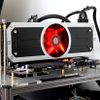PCIe Gen 3 - ZeroCore Power - Eyefinity
PCI Express Generation 3
All cards in the entire AMD Radeon R7 to R9 range are PCI Express Gen 3 compatible which provides a 2x faster transfer rate than the previous generation. This delivers capabilities for next generation of extreme gaming solutions. So opposed to the current PCI Express slots which are at Gen 2, the PCI Express Gen 3 will have twice the available bandwidth and that is 32 GB/s, improved efficiency and compatibility and as such it will offer better performance for current and next gen PCI Express cards. To make it even more understandable, going from PCIe Gen 2 to Gen 3 doubles the bandwidth available to the add-on cards installed, from 500 MB/s per lane to 1 GB/s per lane. So a Gen 3 PCI Express x16 slot is capable of offering 16 GB/s (or 128 Gbit/s) of bandwidth in each direction. That results in 32 GB/sec bi-directional bandwidth. You do need a PCI-E 3.0 compatible motherboard and processor though.
Power Consumption
The R9-295x2 has a rated 500 Watt TDP (maximum power draw) and that really is quite a bit. AMD however focused on idle states as well, when you are in desktop mode for example in the year 2008 on 55nm a graphics card would draw up-to 90 Watt. That changed dramatically on the 40nm nodes and product towards a much better ~20 Watt. A new precedent was being set with the initial R7000 launch though as in desktop idle mode the graphics cards only consume 2.7 Watt. So when the unutilised GPU is more than 95% it can almost shut 99% of itself down, even the ventilator will spin down and disable itself (which is a little freaky when you first see it really). So what's happening there you might ask? Well, as soon as the system goes into long idle state and applications are not actively changing the screen contents, the GPU enters the ZeroCore power state. In the ZeroCore power state, the GPU core (including the 3D engine / compute units, multimedia and audio engines, displays, memory interfaces, etc.) is completely powered down. ZeroCore Power state maintains a very small bus control block to ensure that GPU content is still visible to the operating system and BIOS. The enablement of the ZeroCore Power feature is controlled by the driver. The driver on its end monitors the display contents and allows the GPU to enter the ZeroCore Power, in the condition that the GPU enters long idle and subsequent work requests are no longer being submitted to the engine. If any applications update the screen contents, ZeroCore Power technology can periodically wake the GPU to update the framebuffer contents and put the GPU back into the ZeroCore Power state. Furthermore, applications such as Windows 7/8 desktop gadgets are architected to minimize activity and save power in the long idle state. These applications are active during screen-on mode to display dynamic content such as weather, RSS feeds, stock symbols, system status, etc. but also have the intelligence to suspend any updates and activity when the system enters long idle. These applications will not wake the GPU from the ZeroCore Power state in long idle.
Direct X 11.2
All of AMD's new line-up will support DirectX 11.2 as the hardware is compatible, this also means the entire AMD R9 series will be compatible after a driver upgrade. DX 11.2 is released alongside Windows 8.1
“Today, AMD is the only GPU manufacturer to offer fully-compatible DirectX 11.1 support, and the only manufacturer to support Tiled Resources Tier-2 within a shipping product stack,” AMD said in a statement. The standout feature appears to be Direct3D tiled resources, which allows developers to easily use both GPU and system RAM to store textures. That's huge for console, not so much for high-end graphics cards though.


